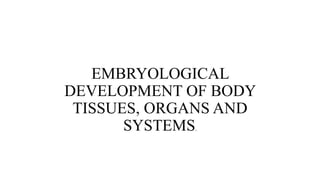The document summarizes key stages in human embryonic development from fertilization through the end of the embryonic period at 8 weeks. It describes fertilization and implantation, then outlines development by week. The first week includes cleavage and blastocyst formation. The second week brings germ layer formation and implantation. The third week involves organogenesis and formation of the heart and blood vessels. Weeks 4-5 see further organ development and limb buds. Weeks 6-8 are a period of rapid growth and tissue maturation as the embryonic period concludes.



































































